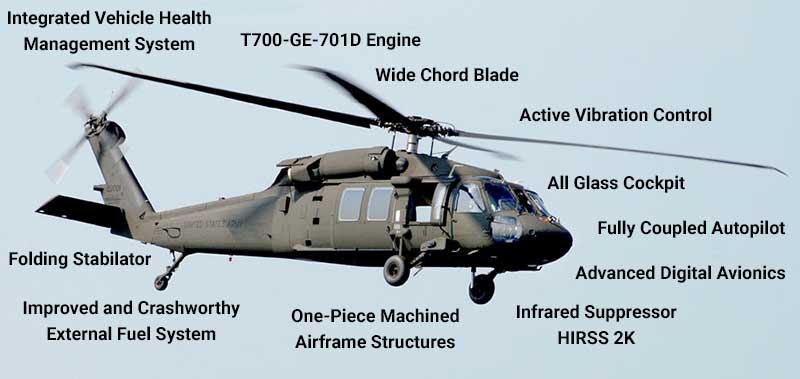UH 60 Helicopter Upkeep: A Comprehensive Overview for Pilots
UH 60 Helicopter Upkeep: A Comprehensive Overview for Pilots
Blog Article
Understanding the Mechanics and Engineering Behind Uh 60 Helicopters
The UH-60 helicopter, commonly called the Black Hawk, stands as a peak of modern rotorcraft technology, personifying a blend of durable engineering and intricate mechanics. From its creation to its existing versions, the development of this aircraft showcases a fusion of innovation and usefulness. As we peel off back the layers of the UH-60's layout, a globe of complex systems and careful engineering emerges. Recognizing the auto mechanics and design behind this versatile airplane unveils a world where precision satisfies power, and where each component plays an essential duty in attaining flight.
Background of UH-60 Helicopters
The history of UH-60 helicopters traces back to the late 1970s when the United States Army looked for a advanced and functional utility helicopter to change its aging fleet. In response to this requirement, the Sikorsky Aircraft Firm developed the UH-60 Black Hawk helicopter. Introduced in 1979, the UH-60 swiftly ended up being a staple in military operations due to its excellent abilities.
The UH-60 was developed to master a range of missions, including troop transportation, clinical evacuation, electronic war, and unique procedures. Its ability to adapt to various duties made it a beneficial possession to the united state Army and other army forces around the world
Over the years, the UH-60 system has actually gone through numerous upgrades and variants to enhance its performance and equal advancing mission requirements. These helicopters have actually seen substantial service in conflicts such as the Gulf War, Afghanistan, and Iraq, showcasing their integrity and convenience in varied operational settings. The UH-60's abundant background is a testimony to its long-lasting heritage as a leading utility helicopter.

Engine and Power Systems
Using innovative propulsion innovation, UH-60 helicopters are geared up with sophisticated engine and power systems to ensure ideal efficiency and integrity in a variety of functional circumstances. The UH-60, frequently called the Black Hawk, is powered by 2 General Electric T700-GE-701D engines, each with the ability of delivering up to 1,940 shaft horse power. These turboshaft engines provide the required thrust for the helicopter to accomplish its objectives efficiently, including troop transportation, clinical emptying, and fight support.

Rotor System and The Rules Of Aerodynamics
Just how do the rotor system and the rules of aerodynamics of UH-60 helicopters add to their functional efficiency and flight capabilities? The blades system of the UH-60 helicopter plays an important role in offering lift and propulsion. The UH-60 features a four-bladed, fully expressed blades system that permits high ability to move and security during flight. This style enables the helicopter to perform a variety of objectives, from transportation and clinical evacuation to fight operations.
Aerodynamics additionally play a vital role in the performance of UH-60 helicopters. The streamlined fuselage and rotor blade design minimize drag, enabling the helicopter to accomplish greater speeds and far better gas efficiency. The aerodynamic style of the UH-60 additionally adds to its ability to operate in varied ecological conditions, consisting of hot temperature levels and high elevations.
Avionics and Flight Control Systems

In its intricate sychronisation with the blades system and the rules of aerodynamics of UH-60 helicopters, the avionics and trip control systems form a crucial network of technologies shaping the airplane's functional abilities. In the UH-60, these systems include digital displays, communication radios, General practitioner navigation, climate radar, and auto-pilot systems.
The flight control systems of the UH-60 are accountable for converting the pilot's inputs right into the appropriate adjustments to the blades system, making sure secure flight and ability to move. These systems contain hydraulic actuators, servos, and computer systems that collaborate to regulate the main and tail rotors, in addition to other flight control surface areas. By precisely taking care of the helicopter's trip dynamics, these systems allow pilots to perform a vast array of objectives, from transport and search-and-rescue to deal with procedures, with precision and self-confidence.
Duty and Applications in Aeronautics
The function and applications of avionics and flight control systems in aviation are important to making sure the effective and secure operation of aircraft, including UH-60 helicopters. Avionics systems in UH-60 helicopters encompass a variety of digital systems that help in navigating, communication, monitoring, and controlling numerous airplane functions. These systems include digital screens, autopilot systems, interaction radios, GPS navigating devices, and weather radar. Trip control systems play a vital duty in steering the helicopter airborne, preserving security, and from this source making sure precise movements. The fly-by-wire technology utilized in contemporary UH-60 helicopters equates pilot inputs into digital signals, which are then analyzed by the trip control computer systems to readjust the airplane's control surfaces. Additionally, these systems integrate safety and security attributes such as autopilot settings, terrain understanding alerting systems, and stability augmentation systems to enhance the general safety and security and functional capabilities of the UH-60 helicopters in numerous missions, including troop transport, medical evacuation, search and rescue, top article and airborne firefighting.
Verdict
In final thought, the UH-60 helicopter is a functional airplane with a rich background and progressed engineering. Its engine and power systems, rotor system, the rules of aerodynamics, avionics, and trip control systems all work together to make it a trustworthy and reliable device.
In its elaborate sychronisation with the rotor system and aerodynamics of UH-60 helicopters, the avionics and trip control systems create a critical network of modern technologies forming the aircraft's operational capabilities.The flight control systems of the UH-60 are liable for translating the pilot's inputs into the appropriate adjustments to the blades system, ensuring stable trip and ability to move. Avionics systems in UH-60 helicopters incorporate a variety of digital systems that help in navigation, interaction, surveillance, and managing various aircraft features. Furthermore, these systems incorporate security functions such as auto-pilot settings, terrain recognition cautioning systems, and stability enhancement systems to enhance the total security and operational capacities of the UH-60 helicopters in different objectives, including troop transportation, clinical discharge, search and rescue, and airborne firefighting.
Its engine and power click this link systems, rotor system, aerodynamics, avionics, and trip control systems all function together to make it a efficient and trusted machine.
Report this page